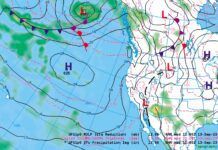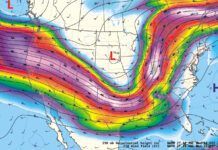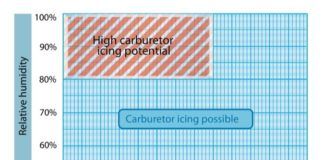Another season of turbulent spring weather is just ahead, so it’s a good time to go over storm safety. We’ll do that once again by discussing a pertinent weather-related accident. Although at first glance the lessons might seem obvious, we’ll use this fateful ride-along to discuss some key concepts I’ve observed as a meteorologist, and point out some techniques that you might find useful someday during a rough ride.
Not the Best Day
Our case study takes us to the pre-dawn hours of a stormy March morning in western Tennessee. The accident aircraft was a Eurocopter AS350, registered to a regional hospital network. The helicopter was state of the art, equipped with MFDs, EGPWS, and night vision equipment. During this unsettled night, it arrived at Jackson-Madison County General Hospital with a patient airlifted from a nearby town. After dropping the patient off, the pilot prepared for the westward return flight to its home base in Brownsville, Tennessee, 23 miles away. The time was 0540L (0540 local).
The 58-year old pilot was a retired Memphis police officer. He held a commercial pilot certificate, as well as multi-engine, rotorcraft, instrument, and instrument helicopter ratings. He had 2200 hours of helicopter flight time. Joining him were two flight nurses.
While the crew prepared for their flight, at home base in Brownsville another company pilot arrived to start his duty day. He entered the hangar and was surprised not to see the helicopter. He was concerned about the rough weather and the forecasts of storms, and called the company flight center to find out what the helicopter was doing. He was told that it was on the pad in Jackson.
Difficult Decisions
After hanging up with dispatch, the company pilot at home base received a phone call from the accident helicopter pilot. “I want to get the helicopter out,” he said, pointing out that he had offloaded on the hospital rooftop and didn’t want to leave the aircraft exposed to the storm where it could be blown over. There was nowhere else to park it.
The two pilots discussed the weather. Based on the radar graphics they had available, they estimated a forward storm speed of 25 mph, far lower than the actual 60 mph speed. The pilots then agreed there was about 18 minutes to get home. It would take the helicopter about 14 minutes to make the flight, arriving at 0605L.
The helicopter lifted off at 0551L. At this time, unknown to both pilots, the leading edge of the thunderstorm line was only six miles from Brownsville. At a 60 mph speed, the storm would close in on Brownsville at 0557L. The flight was already doomed.
As the arrival window slipped past, the company pilot grew anxious and began trying to call the flight nurse. The calls all went to voicemail. He then called flight dispatch.
“Do you got [Helicopter] Five up?” the pilot asked.
The flight center replied, “Yeah, he should be coming in about the next thirty seconds.”
“There’s a line of thunderstorms that’s right here.”
“Yeah, yeah I know. Got to get word to him. Hope he’ll be all right now.”
“Alright, well maybe he’ll be landing shortly.”
The dispatcher checked a computer display. “Okay, I’ve got him just… east of you. Should be landing within, I’ll tell you, the last time he pinged off he was slowing down to 92 mph.”
“Okay.”
“Thanks man.”
“See you.”
Moments of tense waiting turned to minutes. The storm quickly died as it moved northeast, but the helicopter never arrived.
The company pilot ran to the next building to summon the ambulance service. The alert went out, cascading into a multi-agency search as dawn gave way to a dreary, wet morning. The helicopter was quickly located by EMS workers, firefighters, and deputies in a wheat field about three miles from the destination. The wreckage was almost unrecognizable, and it was still burning. Eight investigators from the NTSB flew in that afternoon from Washington, DC.
The debris field showed rotor blade fragments and the left landing gear skid in the initial ground scars. Investigators concluded the helicopter struck the ground nose-level with a 33-degree left bank. The wreckage was mostly destroyed by a post-impact fire. However close inspection showed no sign of any equipment failures.
As the lighting detection network showed extensive cloud-to-ground lightning activity in the area, investigators looked for the possibility of lightning strike. This was done by examining the rotor blade bonding braids. These indicated that lightning did not strike the helicopter. Agricultural irrigation equipment at the crash scene did not show evidence of lightning strikes, either.
From all the data available, it appears the helicopter punched through the gust front, entering a wall of heavy rain, and was downed. The NTSB concluded IMC, heavy rain, and severe turbulence led to a loss of control.
Satellite Weather
The helicopter was equipped with an Avidyne FlightMax EX500 displaying satellite XM Weather datastream. Recovery of the circuit boards allowed investigators to see exactly which products were selected and received.

A stamp at the bottom left of the display shows the age of the product. However this only shows the time elapsed between the product time and the current time. Other factors can further extend the latency after the storm cloud was actually sampled by the radar. This includes completion of the selected volume coverage pattern, as well as upload, processing, and distribution time. All of this means that it can be as long as 10 minutes between the time the cloud was sampled and the image arrives in the cockpit.
Furthermore, with a rapidly progressing situation such as a fast-moving squall line, it can be almost impossible for a pilot to accurately project the arrival time of a storm. This was one of the major factors that led to the pilot misjudging the threat. While the helicopter prepared for its final return flight, the helicopter’s XM display showed an image from 0530L. This was also the only radar image that the pilot received until much later, during the flight, and it showed the storms still 30 miles from home base.
A pilot seeing the storm almost 30 miles from the destination, using a typical storm movement of 30 mph, would assume there’s an hour before things would get bad. It’s clear that both company pilots were working from an incomplete picture of storm motion, timing, and strength.

Findings
To get an idea of how well the company pilots understood the limitations of in-cockpit radar displays, investigators asked them how old they thought the data displays were. One pilot felt the WSI ADS-B radar depictions were real-time, with no delay, and that XM Weather depictions carried a delay, but that it was only 30 to 60 seconds. Another pilot thought that the delays of both systems were about ten minutes. Yet another pilot felt these values were somewhere in between.
In its final report, the NTSB was compelled to add a special section on preventing similar accidents. It pointed out these findings:
- The “age indicator” on NEXRAD products does not show the age of actual conditions. • Weather will always be older than the age indicated on the display.
- In extreme latency and mosaic creation scenarios, the discrepancy between age indication and the sampling of radar echoes can exceed 15 to 20 minutes.
- Having in-cockpit weather capabilities does not circumvent the need for a complete weather briefing before takeoff.
- Finally, in-cockpit NEXRAD shows where the weather was, not where it is. I will suffix this NTSB quote by stating that this principle is true even in tools used by meteorologists, where latency is commonly on the order of 30 seconds to a few minutes.
Severe Weather Potential
The rapid movement of the squall line is a red flag for damaging winds. My own analysis of the radar imagery shows that the line moved 32 miles in 30 minutes, yielding a forward speed of 64 mph. This correlates well with the NTSB report, which gave the motion as 61 knots (70 mph), and 60 mph given by a special weather statement by the National Weather Service in Memphis.
A storm’s forward speed generally serves as a useful starting estimate to predict surface wind gusts. This makes sense because the cold pool initially moves with the mid-level wind flow, which is closely tied to storm motion. This cold pool retains much of that forward momentum when it reaches the ground; even if some momentum is lost, wind gusts will still exceed the sustained wind speed by a significant margin.
Not all storms that move 60 mph will produce a 60 mph wind, but forecasters must assume that potential is there unless there’s reason to think otherwise, such as when a storm has weak reflectivity and low VIL (vertically integrated liquid) values. But if high winds are expected, there’s great potential for low-level turbulence and low-level wind shear because of the many interactions that take place between momentum, friction, shear, and rough terrain.
Forecasters anticipate downburst potential through DCAPE and Corfidi vectors, and verify hazardous storms through spotter and law enforcement reports. But NEXRAD velocity products provide useful information. Doppler wind velocities displayed along the leading edge of a storm serve as a good rule of thumb for surface wind gust speed. This is a good technique to use if you like looking at radar velocity products on the Internet. Spotted or irregular appearances of high wind signatures furthermore suggest microburst potential.
There are a few assumptions here, though. You must be within about 50 miles of the radar echo, otherwise the radar beam is higher than 4000 feet AGL and the wind speeds there won’t be representative of surface conditions. You also must use the lowest radar tilt, typically 0.5 degrees.
Since radar only measures the wind component toward or away from the radar antenna, the radar beam must be parallel with storm movement to properly evaluate winds. If your radar beam is perpendicular to the storm motion, you won’t detect much of its forward motion. Forecasters sometimes have to grudgingly choose cells that are in a better position with respect to the radar beam in order to guess what kind of wind the other cells might be producing.
By displaying velocity data as a cross section, a band of horizontal 70-knot winds is revealed at 8000 to 10,000 feet. This band starts west of the storm and descends to the ground at the leading edge of the storm. This is a descending rear-inflow jet. It’s partly created by rolls of horizontal vorticity which develop as warm, moist air flows up into the squall line toward the rear of the storm.
Strong rear-inflow jets closely correlate with bow echoes and derecho windstorms, because the strong momentum of the wind field is ducted to the surface. They’re associated with “rear inflow notches”—areas of weak reflectivity on the back of squall lines where downburst damage and bow echo development occur. No rear inflow notches were in this squall line, but the existence of a rear-inflow jet indicates the potential for strong winds and downbursts.

Lessons To Be Learned
Unfortunately, elaborate graphical cross sections of radar data can’t be produced in the cockpit or on any tablet-based software in common use. This is a reminder that there will always be critical information about a storm that won’t be available to the pilot. Analyzing complex thunderstorms in this kind of detail is beyond the skill set of most pilots anyway, and is absorbing for even an experienced meteorologist.
However simple clues such as the bow shape of the storm and the rapid forward motion coupled with intense reflectivity are clear indicators of danger. When you see storm signatures like the ones shown here, you might want to consider delaying your flight. This is perhaps one of the most valuable takeaways from our analysis.
Another interesting note is that this squall line was not considered particularly notable. Although a special weather statement was issued, no warnings were in effect. The resulting crash, however, settles the question of whether the storm could be considered dangerous.
The FAA bears this out in Circular AC 00-24C: “All thunderstorms have conditions that are a hazard to aviation. These hazards occur in numerous combinations. While not every thunderstorm contains all hazards, it is not possible to visually determine which hazards a thunderstorm contains.” As we can’t sample storms with perfect granularity, and severe weather phenomena quite often still occur unexpectedly, that last sentence also applies even to forecast tools. Thunderstorms bring significant risks, unless you’re equipped with airborne radar.
Furthermore, this case study validates the FAA’s rule about thunderstorms, as written in AC 00-24C: “The best use of ground radar information is to isolate general areas and coverage of echoes in order to avoid the whole thunderstorm area.” I know that’s easier said than done, but I can tell you firsthand the NTSB reports are full of stories like the one you just read, written about pilots who used NEXRAD to decide their storm was just safe enough to fly in.





